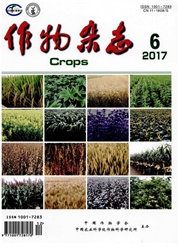

 中文摘要:
中文摘要:
通过综合评价品种(系)的耐寒性,筛选出耐寒性较好的品种。以云南农业大学自育的9个农艺性状优异的甘蔗品系为研究对象,在甘蔗苗期进行低温处理,通过抗逆生理生化指标的变化,采用极点排序法对各品种(系)进行综合评价。结果表明:1低温(3℃)处理使甘蔗叶片的细胞膜电导率、可溶性糖含量、丙二醛含量、脯氨酸含量、可溶性蛋白含量、叶绿素含量、过氧化物酶(POD)活性分别平均增加了21.21%、134.1%、83.60%、35.47%、47.72%、9.07%、565.2%。2低温(3℃)处理使甘蔗叶片的超氧化物歧化酶(SOD)活性平均下降19.67%。最终筛选出耐寒性最好的甘蔗品种‘滇蔗03-91’,耐寒性最差的甘蔗品种‘滇蔗02-39’,而‘滇蔗08-5’、‘滇蔗05-103’、‘滇蔗01-58’等品种(系)耐寒性强于‘滇蔗04-14’、‘滇蔗04-429’、‘滇蔗05-522’、‘滇蔗02-227’品种(系)。
 英文摘要:
英文摘要:
This study aimed to screen out cold-tolerant sugarcane cultivars through acomprehensive cold tolerance evaluation. A total of 9 sugarcane cultivars with good agronomic traits, bred by the Yunnan Agricultural University, were selected. They were treated by low temperaturestress (3 ℃), and the changes of their cold-tolerant physiological and biochemical indices were monitored. The cold tolerance of the sugarcane cultivars was evaluated comprehensively by polar ordination. The results showed that the low temperature stress increased the averagemembrane conductivi- ty, soluble sugar content, MDA content, proline content, soluble protein content, chlorophyll content and peroxidase (POD) activity in sugarcane leaves by 21.21%, 134.1%, 83.60%, 35.47%, 47.72%, 9.07% and 565.2%, respectively, but decreased the superoxide dismutase (SOD) activity in sugarcane leaves by 19.67%. Among the 9 sugarcane cultivars, Dianzhe 03-91 showed the strongest cold tolerance, while Dianzhe 02-39 showed the poorest cold tolerance; the cold tolerance of Dianzhe 08-5, Dianzhe 05-103 and Dianzhe 01-58 was stronger than that of Dianzhe 04- 14, Dianzhe 04-429, Dianzhe 05-522 and Dianzhe 02-227.
 同期刊论文项目
同期刊论文项目
 同项目期刊论文
同项目期刊论文
 期刊信息
期刊信息
